
Pantalettes: Short dresses

Figure 1.--This boys dress is quite short, almost like the tunics an older boy might wear with knickers. The tartan patter, a popular material for a boy as it suggested a kilt. The dress has front buttons and a purely ornmental belt which a girl would not have worn. This Daguerotype was probably taken in the 1850s. Notice his wide brimmed hat laying on the table.
|
Beginning about the 1840s it became more acceptable for younger boys and girls to wear shorter dresses. This affected the pantalettes worn with the dresses. As the century progressed, children continued to wear pantaletts, but the length was shortened to mid-calf and then to just below the hem of the dress.
As it was not considered proper for even young children to have bare legs, both boys and girls comminly wore long white stockings-- often with strap shoes. It was not until the 1860s that young children began to appear with bare legs, often with pantalettes at the hem of their dresses. Older girls continued to wear longer pantalettes.
The style of wearing pantalettes with short dresses continued in vogue through the 1860s, but gradually disappeared after the 1870s. This was in part because pantalettes were becoming less stylish and because dresses began to return to lower hem lines. Some particularly elaborate Fauntleroy suits had pantalette-like lace trim and ruffles at the hem of the velvet kneepants. But this was not the most common style.
Christopher Wagner
histclo@lycosmail.com
Navigate the Boys' Historical Clothing Web Site:
[Return to the Main dress page]
[Return to the Main tunic page]
[Return to the Main kilt page]
[Return to the Main Fauntleroy page]
[Return to the Main pantalettes page]
[Introduction]
[Chronology]
[Clothing styles]
[Biographies]
[Bibliographies]
[Activities]
[Contributions]
[Countries]
[FAQs]
[Boys' Clothing Home]
Created: November 24, 1998
Last updated: November 24, 1999


